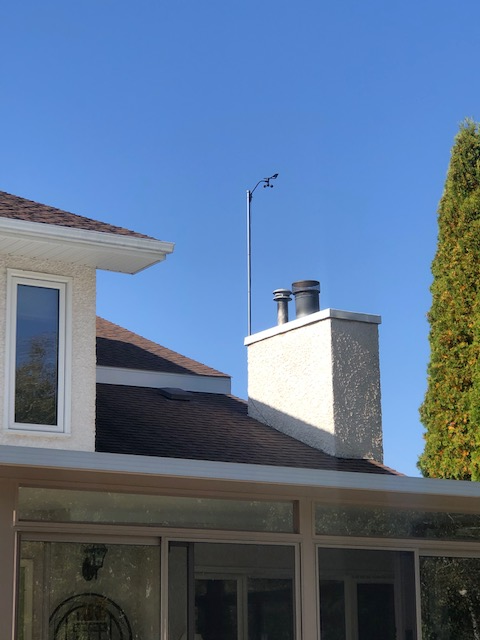Weather
Station details

Main sensor suite
(view NE) |

anemometer siting
(view NW) |
Davis Vantage Pro 2 wireless weather station
(model 6153 - 24 hr fan aspirated)
- station
location: Winnipeg, Manitoba, Canada
- 49 deg 51' N, 97 deg 16' W elevation 235 m (775 ft)
- located in southwest
portion of city (Charleswood)
- original VP station (VP1) installed August 2001
(moved to nearby location August 2010)
-
station upgraded to Vantage
Pro 2 with fan-aspirated shield - Sep 2015
- site exposure: general residential, open backyard backing onto
forest to the north and northeast
- main unit mounted
in backyard, anemometer mounted on chimney on roof
- temperature sensor/rain gauge height ~ 4 ft above ground
- anemometer height ~ 20 feet above ground
- live data website established November 2001 (Rob's
Obs)
(using Weatherlink and VWS software) |
Station accuracy
Wind readings:
Official wind readings are taken from well exposed airport
sites at a height of 10 meters (33 feet) Thus, wind readings from my site (about
2/3rd the
official height and less ideal exposure) will be less than airport observations, usually
by half or more. My wind anemometer is roof mounted on the side of a
chimney, about 20 feet up. Even so, wind speeds are greatly influenced by
neighbourhood trees and houses which dampens the wind considerably and results
in highly variable speeds alternating between light and stronger gusts.
Thus, wind readings from my site will be
under-reported, especially when trees are in full foliage. Wind readings are better
between October and May when surrounding trees are bare. Full tree foliage
will lead to lower overall wind readings during the summer months. Note
that due to the less than ideal wind exposure at my site, wind chill readings
will always be underdone compared to official airport values. As a result, it is not
recommended to use my site to monitor wind chill values such as for schoolyard
purposes.
Temperature:
The temperature sensor is housed in a 24 hr fan
aspirated radiation shield on
the unit placed in full sun. Temperatures are generally quite reliable (within 0.5C of
official readings).. especially on cloudy and/or windy days. However during sunny,
light wind days, my station will usually
register readings that are about 1C too high compared with official airport observations. This
is most evident from mid morning through early afternoon when the unit gets full solar
radiation and there is little ventilation to mix the air surrounding the unit. My
backyard has a southern exposure and will warm up considerably in sunny light wind
situations.
Humidity:
The humidity sensor is housed with the temperature sensor
inside the fan aspirated radiation shield. I have found humidity readings are quite reliable,
often within 5-10% of official readings. Most often, humidity readings tend to be a
little higher than official airport observations mainly due to less ideal mixing. However,
my sensor seems to reach a maximum relative humidity of about 88%, even in dense
fog situations.
Note that the dew point is calculated directly from the relative humidity reading
and air temperature.
Rainfall:
Rainfall is the most variable parameter, and depends
largely on the prevailing wind direction, and the intensity of rainfall. Generally,
I have found that the unit is very comparable to my nearby official weather service rain gauge
(Type B standard gauge), often within 0.5 mm of each other. However, I
have noted that my VP gauge tends to underestimate rainfall in events with a
prevailing north wind, since the unit is somewhat sheltered by trees to the
north. Note also that tipping bucket rain gauges tend to underestimate
rainfall in high intensity cases. My VP rain gauge is not equipped with a heater..
thus winter precipitation is not recorded. Rain does not generally occur in this
climate from November through February. Rainfall season begins April 1st.

